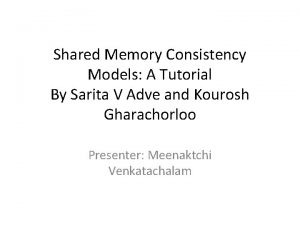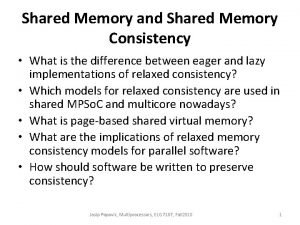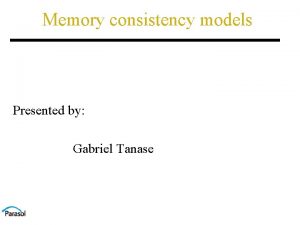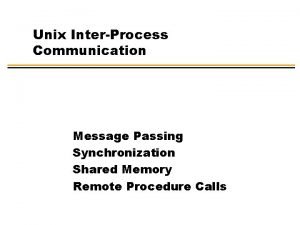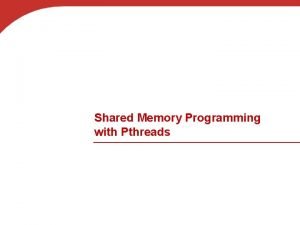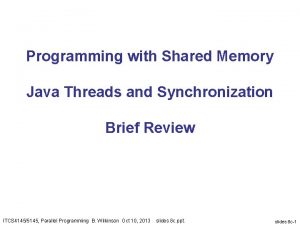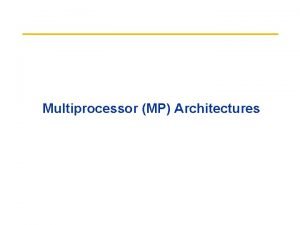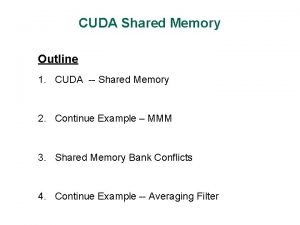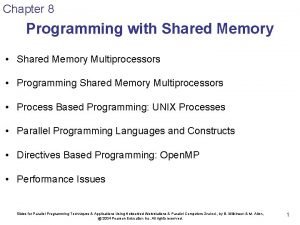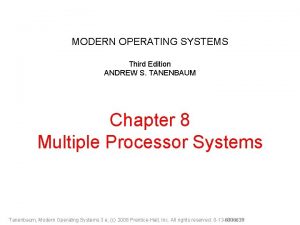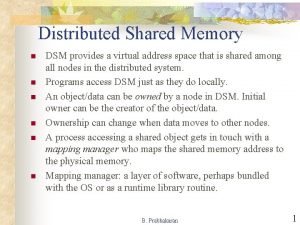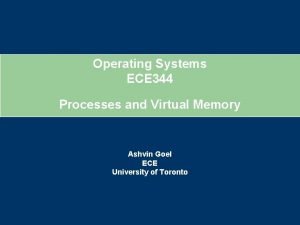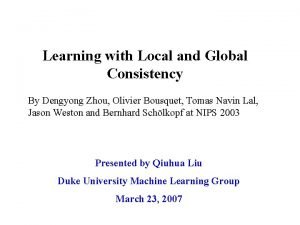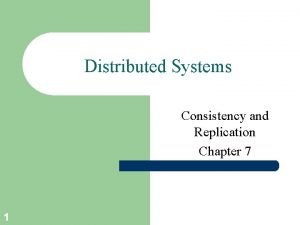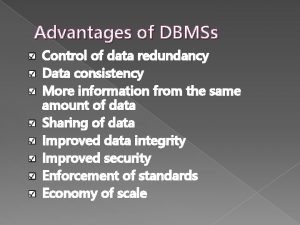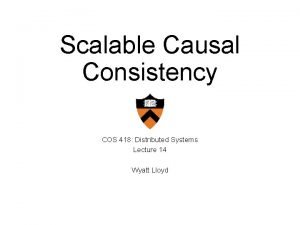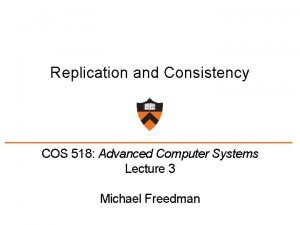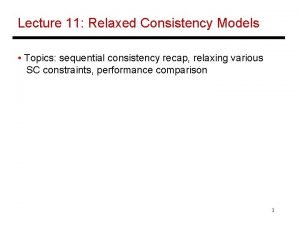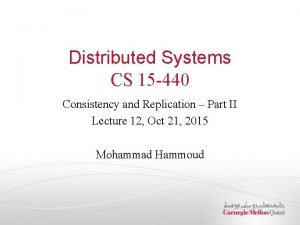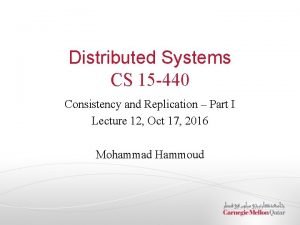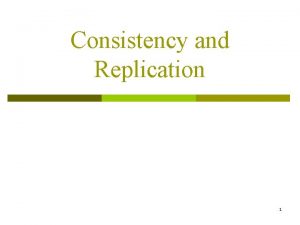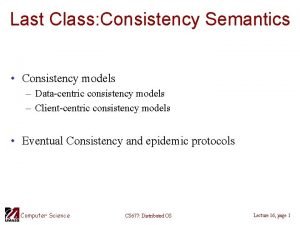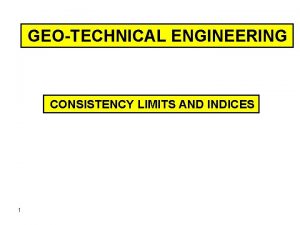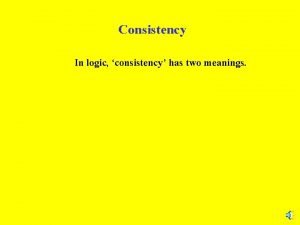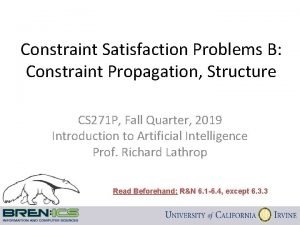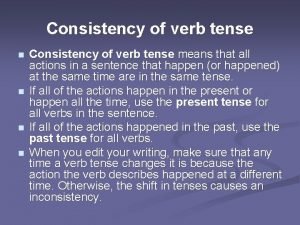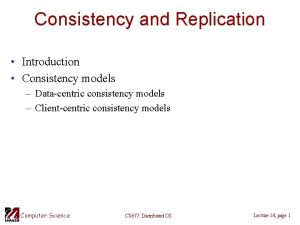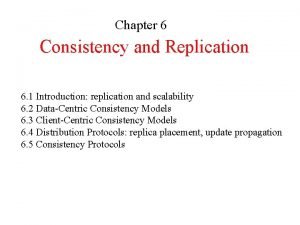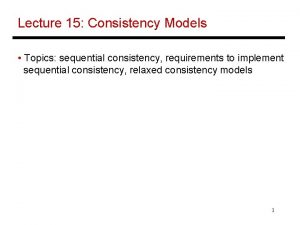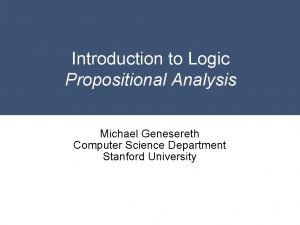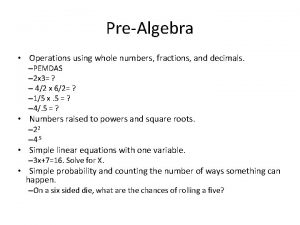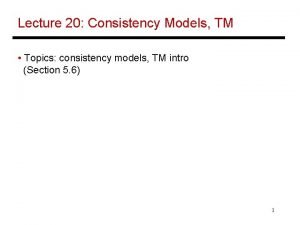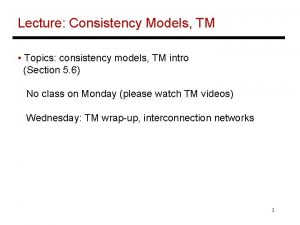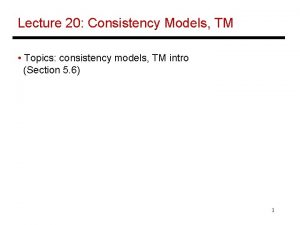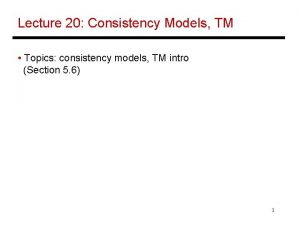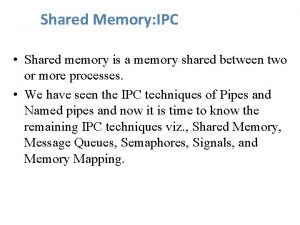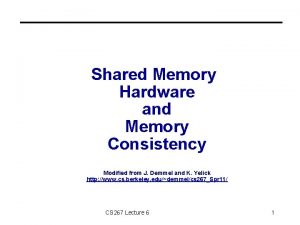Shared Memory and Memory Consistency Models Daniel J


























![Optimized Implementations of SC • Famous paper by Gharachorloo et al. [ICPP 1991] shows Optimized Implementations of SC • Famous paper by Gharachorloo et al. [ICPP 1991] shows](https://slidetodoc.com/presentation_image_h2/6d374f60bb88dbbdc2719308134b22fe/image-27.jpg)



































































- Slides: 94

Shared Memory and Memory Consistency Models Daniel J. Sorin Duke University UPMARC 2016

Who Am I? • Professor of ECE and Computer Science • From Duke University – In Durham, North Carolina • My research and teaching interests – – Cache coherence protocols and memory consistency Fault tolerance Verification-aware computer architecture Special-purpose processors (C) Daniel J. Sorin UPMARC 2016 2

Who Are You? • People interested in memory consistency models – Important topic for computer architects and writers of parallel software • People who could figure out the Swedish train system to get here from Arlanda Airport – SJ? SL? ? UL? ? ? (C) Daniel J. Sorin UPMARC 2016 3

Optional Reading • Daniel Sorin, Mark Hill, and David Wood. “A Primer on Memory Consistency and Cache Coherence. ” Synthesis Lectures on Computer Architecture, Morgan & Claypool, 2011. http: //www. morganclaypool. com/doi/abs/10. 2200/S 0034 6 ED 1 V 01 Y 201104 CAC 016 (C) Daniel J. Sorin UPMARC 2016 4

Outline • Overview: Shared Memory & Coherence – Chapters 1 -2 of book that you don’t have to read • • • Intro to Memory Consistency Weak Consistency Models Case Study in Avoiding Consistency Problems Litmus Tests for Consistency Including Address Translation Consistency for Highly Threaded Cores (C) Daniel J. Sorin UPMARC 2016 5

Baseline Multicore System Model (C) Daniel J. Sorin UPMARC 2016 6

What is (Hardware) Shared Memory? • Take multiple microprocessor cores • Implement a memory system with a single global physical address space • Hardware provides illusion of single shared address space – Even when cores have caches (next slide) • Single address space sounds great … – … but what happens when cores have caches? Let’s see how caches can lead to incoherence … (C) Daniel J. Sorin UPMARC 2016 7

Cache Coherence Problem (Step 1) P 2 load r 2, x Time P 1 Interconnection Network x Main Memory (C) Daniel J. Sorin UPMARC 2016 8

Cache Coherence Problem (Step 2) P 2 Time P 1 load r 2, x Interconnection Network x Main Memory (C) Daniel J. Sorin UPMARC 2016 9

Cache Coherence Problem (Step 3) P 2 Time P 1 load r 2, x add r 1, r 2, r 4 store x, r 1 Interconnection Network x Main Memory (C) Daniel J. Sorin UPMARC 2016 10

Cache Coherence Protocol • • Cache coherence protocol (hardware) enforces two invariants with respect to every block We’ll think about both invariants in terms of epochs – • Divide lifetime of each block into epochs of time So what are the two invariants? time (C) Daniel J. Sorin UPMARC 2016 11

Cache Coherence Invariant #1 1. Single Writer Multiple Reader (SWMR) invariant SWMR: at any time, a given block either: – – has one writer one core has read-write access zero or more readers some cores have read-only access read-only cores: 1, 4 read-write core: 3 read-only cores: 1, 3, 6 time (C) Daniel J. Sorin UPMARC 2016 12

Cache Coherence Invariant #2 2. Data invariant: up-to-date data transferred The value at the beginning of each epoch is equal to the value at the end of the most recently completed read-write epoch read-only cores: 1, 4 value = 2 read-write core: 3 value = 2 3 read-only cores: 1, 3, 6 value=3 time (C) Daniel J. Sorin UPMARC 2016 13

Cache Coherence Protocols • • • All any coherence protocol does is enforce these two invariants at runtime Many possible ways to do this Tradeoffs between performance, scalability, power, cost, etc. (C) Daniel J. Sorin UPMARC 2016 14

Implementing Cache Coherence Protocols • • • But fundamentally all protocols do same thing Cache controllers and memory controllers send messages to coordinate who has each block and with what value For now, just assume we have a coherence protocol – This is one of my favorite topics, so I’ll have to refrain for now (C) Daniel J. Sorin UPMARC 2016 15

Why Cache-Coherent Shared Memory? • Pluses – – For applications - looks like multitasking uniprocessor For OS - only evolutionary extensions required Easy to do inter-thread communication without OS Software can worry about correctness first and then performance • Minuses – Proper synchronization is complex – Communication is implicit so may be harder to optimize – More work for hardware designers (i. e. , me!) • Result – Most modern multicore processors provide cache-coherent shared memory (C) Daniel J. Sorin UPMARC 2016 16

Outline • Overview: Shared Memory & Coherence • Intro to Memory Consistency – Chapter 3 • • • Weak Consistency Models Case Study in Avoiding Consistency Problems Litmus Tests for Consistency Including Address Translation Consistency for Highly Threaded Cores (C) Daniel J. Sorin UPMARC 2016 17

Coherence vs. Consistency • Programmer’s intuition says load should return most recent store to same address – But which one is the “most recent”? • Coherence concerns each memory location independently • Consistency concerns apparent ordering for ALL memory locations (C) Daniel J. Sorin UPMARC 2016 18

Why Coherence != Consistency // initially, A = B = flag = 0 Thread 1 Thread 2 Store A = 1; while (Load flag==0); // spin Store B = 1; Load A; Store flag = 1; Load B; print A and B; • Intuition says Thread 2 should print A = B = 1 • Yet, in some consistency models, this isn’t required! • Coherence doesn’t say anything … why? (C) Daniel J. Sorin UPMARC 2016 19

Why Memory Consistency is Important • Memory consistency model defines correct behavior – It is contract between system and programmer – Analogous to ISA specification – Consistency is part of architecture software-visible • Coherence protocol is only a means to an end – Coherence is not visible to software (i. e. , not architectural) – Enables new system to present same consistency model despite using newer, fancier coherence protocol – Systems maintain backward compatibility for consistency (like ISA) • Reminder to architects: consistency model restricts ordering of loads/stores – Does NOT care at all about ordering of coherence messages (C) Daniel J. Sorin UPMARC 2016 20

Sequential Consistency (SC) • Leslie Lamport 1979: “A multiprocessor is sequentially consistent if the result of any execution is the same as if the operations of all the processors were executed in some sequential order, and the operations of each individual processor appear in this sequence in the order specified by its program” • First precise definition of consistency • Most restrictive consistency model • Most intuitive model for (most) humans (C) Daniel J. Sorin UPMARC 2016 21

The Memory Model sequential processor cores issue memory ops in program order P 1 Pn P 2 switch randomly set after each memory op Memory (C) Daniel J. Sorin UPMARC 2016 22

SC: Definitions • Sequentially consistent execution – Result is same as one of the possible interleavings on uniprocessor • Sequentially consistent system – Any possible execution corresponds to some possible total order • Preferred (and equivalent) definition of SC – There exists a total order of all loads and stores (across all threads), such that the value returned by each load equals the value of the most recent store to that location (C) Daniel J. Sorin UPMARC 2016 23

SC: More Definitions • Memory operation – Load, store, or atomic read-modify-write (RMW) to memory location • Issue (different from “issue” within core!) – An operation is issued when it leaves core and is presented to memory system (usually the L 1 cache or write-buffer) • Perform – A store is performed wrt to a processor core P when a load by P returns value produced by that store or a later store – A load is performed wrt to a processor core when subsequent stores cannot affect value returned by that load • Complete – A memory operation is complete when performed wrt all cores. • Program execution – Memory operations for specific run only (ignore non-memory-referencing instructions) (C) Daniel J. Sorin UPMARC 2016 24

SC: Table-Based Definition • I like tabular definitions of models – Specify which program orderings are enforced by consistency model » Remember: program order defined per thread – Includes loads, stores, and atomic read-modify-writes (RMWs) – “X” denotes ordering enforced (C) Daniel J. Sorin UPMARC 2016 25

SC and Out-of-Order (OOO) Cores • At first glance, SC seems to require in-order cores • Conservative way to support SC – Each core issues its memory ops in program order – Core must wait for store to complete before issuing next memory operation – After load, issuing core waits for load to complete, and store that produced value to complete before issuing next op – Easily implemented if cores connected with shared (physical) bus • But remember: SC is an abstraction – Difference between architecture and micro-architecture • Can do whatever you want, if illusion of SC! (C) Daniel J. Sorin UPMARC 2016 26
![Optimized Implementations of SC Famous paper by Gharachorloo et al ICPP 1991 shows Optimized Implementations of SC • Famous paper by Gharachorloo et al. [ICPP 1991] shows](https://slidetodoc.com/presentation_image_h2/6d374f60bb88dbbdc2719308134b22fe/image-27.jpg)
Optimized Implementations of SC • Famous paper by Gharachorloo et al. [ICPP 1991] shows two techniques for optimization of OOO core – Both based on consistency speculation – That is: speculatively execute and undo if violate SC – In general, speculate by issuing loads early and detecting whether that can lead to violations of SC • MIPS R 10000 -style speculation – – Non-speculatively issue & commit stores at Commit stage (in order) Speculatively issue loads at Execute stage (out-of-order) Track addresses of loads between Execute and Commit If other core does store to tracked address (detected via coherence protocol) mis-speculation – Why does this work? (C) Daniel J. Sorin UPMARC 2016 27

Optimized Implementations of SC, part 2 • Data-replay speculation – – Non-speculatively issue & commit stores at Commit stage (in order) Speculatively issue loads at Execute stage (out-of-order) Replay loads at Commit If load value at Execute doesn’t equal value at Commit misspeculation – Why does this work? • Key idea: consistency is interface (illusion) – If software can’t tell hardware violated consistency, it’s OK – Analogous to cores that execute out-of-order while presenting inorder (von Neumann) illusion (C) Daniel J. Sorin UPMARC 2016 28

Outline • Overview: Shared Memory & Coherence • Intro to Memory Consistency • Weak Consistency Models – Chapters 4 -5 • • Case Study in Avoiding Consistency Problems Litmus Tests for Consistency Including Address Translation Consistency for Highly Threaded Cores (C) Daniel J. Sorin UPMARC 2016 29

Why Relaxed Memory Models? • Recall SC requires strict ordering of reads/writes – Each processor generates a local total order of its reads and writes (R R, R W, W W, & R W) – All local total orders are interleaved into global total order (C) Daniel J. Sorin UPMARC 2016 30

Why Relaxed Memory Models? • Relaxed models relax some of these constraints – TSO: Relax ordering from writes to reads (to diff addresses) – XC: Relax all read/write orderings (but add “fences”) • Why do we care? – May allow hardware optimizations prohibited by SC – May allow compiler optimizations prohibited by SC • Many possible models weaker than SC Let’s start with Total Store Order (TSO) … (C) Daniel J. Sorin UPMARC 2016 31

TSO/x 86 • Total Store Order (TSO) – First defined by Sun Microsystems – Later shown that Intel/AMD x 86 is nearly identical “TSO/x 86” • Less restrictive than SC – Tabular ordering of loads, stores, RMWs, and FENCEs – X=ordered – B=data value bypassing required if to same address (C) Daniel J. Sorin UPMARC 2016 32

TSO/x 86: Relax Write to Read Order // initially, A = B = 0 Thread 1 Thread 2 Store A = 1; Store B = 1 Load r 1 = B; Load r 2 = A; • TSO/x 86 core – Allows r 1==r 2==0 (not allowed by SC) • Why do this? stores FIFO write buffer loads – Allows FIFO write buffers performance! – Does not confuse programmers (too much) cache (C) Daniel J. Sorin UPMARC 2016 33

Write Buffers w/ Read Bypass P 2 P 1 Read Flag 2 t 1 Write Flag 1 Read Flag 1 t 2 t 3 Write Flag 2 t 4 Shared Bus Flag 1: 0 Flag 2: 0 Thread 1 Flag 1 = 1 if (Flag 2 == 0) critical section (C) Daniel J. Sorin Thread 2 Flag 2 = 1 if (Flag 1 == 0) critical section UPMARC 2016 34

TSO/x 86: Adding Order When Needed // initially, A = B = 0 Thread 1 (T 1) Thread 2 (T 2) Store A = 1; Store B = 1 FENCE Load r 1 = B; Load r 2 = A; • Need to add explicit ordering if you want it – Unlike SC, where everything ordered by default • FENCE instruction provides ordering – FENCE is part of ISA – No instructions can be reordered across FENCE » E. g. , FENCE prohibits Ld r 1=B from occurring before St A=1 (C) Daniel J. Sorin UPMARC 2016 35

TSO Also Provides “Causality” (Transitivity) // initially all locations are 0 T 1 St A = 1; St flag 1 = 1; T 2 while (Ld flag 1==0) {}; St flag 2 = 1; T 3 while (Ld flag 2==0) {}; Ld r 3 = A; • We expect T 3’s Ld r 3=A to get value 1 • All commercial versions of TSO guarantee causality (C) Daniel J. Sorin UPMARC 2016 36

So Why Not Relax All Order? // initially all 0 T 1 T 2 L 1: Ld r 1 = flag; // spin St A=1; if (r 1 != 1) goto L 1 // loop St B=1; Ld r 1 = A; St flag = 1; Ld r 2 = B; • SC and TSO always order red ops & order green ops – But that’s overkill we don’t need to order them – Reordering could allow for OOO processors, non-FIFO write buffers, some coherence optimizations, etc. • Opportunity: instead of ordering everything by default, only order when you need it (C) Daniel J. Sorin UPMARC 2016 37

But What’s the Catch? // initially all 0 T 1 T 2 L 1: Ld r 1 = flag; // spin St A=1; if (r 1 != 1) goto L 1 // loop St B=1; Ld r 1 = A; St flag = 1; Ld r 2 = B; • What if St flag=1 can be reordered before St A=1? • Or if Ld r 1=A can be reordered before loading flag=1? • We want some order – Red ops before St flag=1 – Green ops after loading flag=1 (C) Daniel J. Sorin UPMARC 2016 38

Order with FENCE Operations // initially all 0 T 1 St A=1; St B = 1; FENCE; St flag = 1; T 2 L 1: Ld r 1 = flag; // spin if (r 1 != 1) goto L 1 // loop FENCE; Ld r 1=B; Ld r 2 = B; • FENCE orders everything above it before everything after it – T 1’s FENCE: If thread sees flag=1, must also see A=1, B=1 – T 2’s FENCE: T 2 can’t do loads of r 1, r 2 before seeing flag set (C) Daniel J. Sorin UPMARC 2016 39

Many Flavors of Weak Models • Many possible models weaker than SC and TSO – Most differences pretty subtle • XC in primer (like what is often called Weak Ordering) – One type of FENCE – X=order, A=order if same address, B=bypassing if same address (C) Daniel J. Sorin UPMARC 2016 40

Release Consistency (RC) • Like XC but two types of one-way FENCEs – Acquire and Release • Acquire: Acquire Ld, St • Release: Ld, St Release (C) Daniel J. Sorin UPMARC 2016 41

XC Example Read / Write … Read/Write FENCE Read / Write … Read/Write (C) Daniel J. Sorin UPMARC 2016 42

Release Consistency Example Read / Write … Read/Write Acquire Read / Write … Read/Write Release (C) Daniel J. Sorin UPMARC 2016 Read / Write … Read/Write 43

The Programming Interface • XC and RC require synchronized programs • All synchronization operations must be labeled and visible to the hardware – Easy (easier!) if synchronization library used – Must provide language support for arbitrary Ld/St synchronization (event notification, e. g. , flag) • Program written for weaker model OK on stricter – E. g. , SC is a valid implementation of TSO, XC, or RC (C) Daniel J. Sorin UPMARC 2016 44

SC for Data-Race-Free • Data race: two accesses by two threads where: – At least one is a write – They’re not separated by synchronization operations • Data-race-free (DRF) program has no data races – Most correct programs are DRF – can you think of counterexamples? IMPORTANT RESULT • TSO, XC, and RC all provide “SC for DRF” – If program is DRF, then behavior is sequentially consistent – Allows programmer to reason about SC system! • But what if program isn’t DRF (i. e. , has a bug)? – Debugging becomes much more … interesting (C) Daniel J. Sorin UPMARC 2016 45

Outline • • Overview: Shared Memory & Coherence Intro to Memory Consistency Weak Consistency Models Case Study in Avoiding Consistency Problems Litmus Tests for Consistency Including Address Translation Consistency for Highly Threaded Cores (C) Daniel J. Sorin UPMARC 2016 46

Why Architects Must Understand Consistency: A Case Study • What happens when memory consistency interacts with value prediction? • Hint: it’s not obvious! • Note: this is not an important problem in itself the key is to show you must think about consistency when designing multicore processors (C) Daniel J. Sorin UPMARC 2016 47

Informal Example of Problem, part 1 • Student #2 predicts grades are on bulletin board B • Based on prediction, assumes score is 60 Bulletin Board B Grades for Class Student ID (C) Daniel J. Sorin score 1 75 2 60 3 85 slide 48 48

Informal Example of Problem, part 2 • Professor now posts actual grades for this class – Student #2 actually got a score of 80 • Announces to students that grades are on board B Grades for Class Student ID (C) Daniel J. Sorin score 1 75 50 2 60 80 3 85 70 slide 49 49

Informal Example of Problem, part 3 • Student #2 sees prof’s announcement and says, “ I made the right prediction (bulletin board B), and my score is 60”! • Actually, Student #2’s score is 80 • What went wrong here? – Intuition: predicted value from future • Problem is concurrency – Interaction between student and professor – Just like multiple threads, cores, or devices (C) Daniel J. Sorin slide 50 50

Linked List Example of Problem (initial state) • Linked list with single writer and single reader • No synchronization (e. g. , locks) needed Initial state of list Uninitialized node head (C) Daniel J. Sorin A A. data 42 A. next null slide 51 60 B. data null B. next 51

Linked List Example of Problem (Writer) Writer sets up node B and inserts it into list Code For Writer Thread B A. data 42 A. next null (C) Daniel J. Sorin 80 B. data A B. next { Insert head Setup node • slide 52 W 1: store mem[B. data] 80 W 2: load reg 0 mem[Head] W 3: store mem[B. next] reg 0 W 4: store mem[Head] B 52

Linked List Example of Problem (Reader) • Reader cache misses on head and value predicts head=B. • Cache hits on B. data and reads 60. • Later “verifies” prediction of B. Is this execution legal? Predict head=B head Code For Reader Thread ? A. data 42 A. next null (C) Daniel J. Sorin 60 B. data R 1: load reg 1 mem[Head] = B null B. next R 2: load reg 2 mem[reg 1] = 60 slide 53 53

Why This Execution Violates SC • Recall Sequential Consistency – Must exist total order of all operations – Total order must respect program order at each processor • Our example execution has a cycle – No total order exists (C) Daniel J. Sorin slide 54 54

Trying to Find a Total Order { Insert Setup node • What orderings are enforced in this example? Code For Writer Thread Code For Reader Thread W 1: store mem[B. data] 80 R 1: load reg 1 mem[Head] W 2: load reg 0 mem[Head] R 2: load reg 2 mem[reg 1] W 3: store mem[B. next] reg 0 W 4: store mem[Head] B (C) Daniel J. Sorin slide 55 55

Program Order • Must enforce program order Code For Writer Thread Code For Reader Thread W 1: store mem[B. data] 80 R 1: load reg 1 mem[Head] W 2: load reg 0 mem[Head] R 2: load reg 2 mem[reg 1] W 3: store mem[B. next] reg 0 W 4: store mem[Head] B (C) Daniel J. Sorin slide 56 56

Data Order • If we predict that R 1 returns the value B, we can violate SC Code For Writer Thread Code For Reader Thread W 1: store mem[B. data] 80 R 1: load reg 1 mem[Head] = B W 2: load reg 0 mem[Head] R 2: load reg 2 mem[reg 1] = 60 W 3: store mem[B. next] reg 0 W 4: store mem[Head] B (C) Daniel J. Sorin slide 57 57

Value Prediction and Sequential Consistency • Key: value prediction reorders dependent operations – Specifically, read-to-read data dependence order • Execute dependent operations out of program order • Applies to almost all consistency models – Models that enforce data dependence order • Must detect when this happens and recover • Similar to other optimizations that complicate SC (C) Daniel J. Sorin slide 58 58

How to Fix SC Implementations w/Value Pred • Two options from “Two Techniques for …” – Both adapted from ICPP ‘ 91 paper – Originally developed for out-of-order SC cores • (1) Address-based detection of violations – – Student watches board B between prediction and verification Like existing techniques for out-of-order SC processors Track stores from other threads If address matches speculative load, possible violation • (2) Value-based detection of violations – – Student checks grade again at verification Also an existing idea Replay all speculative instructions at commit Can be done with dynamic verification (e. g. , DIVA [MICRO ‘ 99]) (C) Daniel J. Sorin slide 59 59

Outline • • Overview: Shared Memory & Coherence Intro to Memory Consistency Weak Consistency Models Case Study in Avoiding Consistency Problems Litmus Tests for Consistency Including Address Translation Consistency for Highly Threaded Cores (C) Daniel J. Sorin UPMARC 2016 60

Litmus Tests • Goal: short code snippets to test consistency model • Run litmus test many times (hoping for many different inter-thread interleavings) – Make sure no execution produces result that violates consistency model • We’ve already seen a few litmus tests (C) Daniel J. Sorin UPMARC 2016 61

Litmus Test #1: SC vs. TSO // initially, A = B = 0 T 1 T 2 Store A = 1; Store B = 1 Load r 1 = B; Load r 2 = A; • SC: r 1=r 2=0 not allowed cyclic dependence graph • TSO/x 86: all outcomes allowed, including r 1=r 2=0 (C) Daniel J. Sorin UPMARC 2016 62

Litmus Test #2: TSO vs. XC // initially, A = B = flag = 0 T 1 T 2 St A = 1; while (Ld flag == 0); // spin St B = 1; Ld A; St flag = 1; Ld B; print A and B • TSO requires T 2 to print A = B = 1 • XC permits other results (C) Daniel J. Sorin UPMARC 2016 63

Litmus Test #3: Transitivity // initially all locations are 0 T 1 St A = 1; St flag 1 = 1; T 2 while (Ld flag 1==0) {}; St flag 2 = 1; T 3 while (Ld flag 2==0) {}; Ld r 3 = A; • We expect T 3’s Ld r 3=A to get value 1 • All commercial versions of TSO guarantee causality (C) Daniel J. Sorin UPMARC 2016 64

Litmus Test #4: IRIW // Independent Read, Independent Write // initially all locations are 0 T 1 St A = 1; T 2 St B=1; T 3 Ld A; // =1 FENCE; Ld B; // =1? T 4 Ld B; // =1 FENCE; Ld A; // =1? • Well-known litmus test to check for “write atomicity” – Store is logically seen by all cores at once – Some relaxed models enforce write atomicity • What happens if last two loads both equal 0? – No order of stores exists no write atomicity (C) Daniel J. Sorin UPMARC 2016 65

More Litmus Tests • Many more litmus tests exist • Useful for testing and debugging hardware • Useful for reasoning about consistency models (C) Daniel J. Sorin UPMARC 2016 66

Outline • • Overview: Shared Memory & Coherence Intro to Memory Consistency Weak Consistency Models Case Study in Avoiding Consistency Problems Litmus Tests for Consistency Including Address Translation Consistency for Highly Threaded Cores (C) Daniel J. Sorin UPMARC 2016 67

Translation-oblivious Memory Consistency • Lamport’s definition of Sequential Consistency – Operations of individual processor appear in program order on Physical or Virtual addresses? – The total order of operations executed by different processors obeys some sequential order • Memory system includes Address Translation (AT) – We need AT-aware specifications (C) Daniel J. Sorin 68

Memory Consistency – Traditional View • Monolithic interface between hardware and software Software Memory Consistency Model Hardware (C) Daniel J. Sorin 69

Memory Consistency – Multi-level View HLL Memory Consistency Compiler User-level binaries User Process Memory Consistency Mapped software Virtual Address Memory Consistency (VAMC) Unmapped software • Memory consistency represents a set of interfaces – Supports different layers of software • AT supports mapped software – Interacts with PAMC and VAMC – How does AT impact their specifications? Physical Address Memory Consistency (PAMC) Hardware (C) Daniel J. Sorin 70

PAMC – Physical Address Consistency • Supports unmapped software – Relies only on hardware – Fully specified by the architecture • Adapting AT-oblivious specifications straightforward – All operations refer to physical addresses Operation 1 Weak Order PAMC (C) Daniel J. Sorin Operation 2 LD phys ST phys Mem. Bar LD phys A X ST phys A A X Mem. Bar X X X Legend X = enforced order A = order if same physical address 71

From PAMC to VAMC LD ST Op 2 LD ST Physical addresses + Translation Address Translation → VAMC Ordering Op 1 PAMC Ordering LD ST Op 2 LD ST Virtual addresses Mapping Permissions Status • Translations – Regulate Virtual→Physical address conversions through mappings – Include permissions and status bits – Defined in memory page table, cached in TLBs for expedited access (C) Daniel J. Sorin 72

AT’s Impact on VAMC LD ST Op 2 LD ST Physical addresses + AT Translations → VAMC Ordering Op 1 PAMC Ordering LD ST Op 2 LD ST Virtual addresses • Intuitively, PAMC + AT = VAMC • Three AT aspects impact VAMC – Synonyms - multiple virtual addresses for same data – Mappings/permissions changes » Map/Remap Functions (MRFs) » Maintain coherence between page table and TLBs – Status bit updates (C) Daniel J. Sorin 73

Why MRF Ordering Matters Thread 1 • Two threads operating on same virtual MRF address VA 1 • TLB Invalidation ordering impacts final result • Enforcing MRF ordering eliminates ambiguity (C) Daniel J. Sorin Thread 2 Initially VA 1→PA 1; PA 1=0; PA 2= 0 Map VA 1 to PA 2 Invalidate TLB copies for VA 1 Invalidate barrier Mem. barrier Sync threads Store VA 1 = C Load x = VA 1 PA 1=C PA 2=C Sync threads x=PA 2 X = C or X = 0 ? TLB 1 VA 1→PA 2 VA 1→PA 1 TLB 2 VA 1→PA 1 Pending Invalidate VA 1 74

Specifying AT-Aware VAMC • Possible VAMC specification based on Weak Order q q q n LD/ST refer to synonym sets of virtual addresses MRFs are serialized wrt. any other operation Status bits updates ordered only wrt. to Mem. Bar and MRF Correct AT is critical for VAMC correctness Operation 1 Weak Order VAMC Operation 2 LD syn ST syn Mem. Bar MRF A X X SB ST syn A A X X Mem. Bar X X X MRF SB (C) Daniel J. Sorin X Legend X = enforced order A = order if same address synonym set 75

Framework for AT Specifications • Framework characterizes AT state, not specific implementation • Translations defined in page table, cached in TLBs n Page Table TLB VP 1→PP 1 VP 2→PP 2 VP 3→PP 3 VP 1→PP 1 VP 1 ->PP 1 VP 2→PP 2 Invariant #1. Page table is correct q Software-managed data structure (C) Daniel J. Sorin n Core Invariant #2. Translations are coherent q Hardware/software managed 76

AT Model - ATsc • Sequential model of AT – Similar, but not identical to AT models supported by x 86 hardware running Linux – Translation accesses and status bit updates occur atomically with instructions – MRFs are logically atomic » Implementation uses locks • Model supports PAMCsc + ATsc = VAMCsc (C) Daniel J. Sorin 77

Outline • • Overview: Shared Memory & Coherence Intro to Memory Consistency Weak Consistency Models Case Study in Avoiding Consistency Problems Litmus Tests for Consistency Including Address Translation Consistency for Highly Threaded Cores (C) Daniel J. Sorin UPMARC 2016 78

Overview • Massively Threaded Throughput-Oriented Processors (MTTOPs) like GPUs are being integrated on chips with CPUs and being used for general purpose programming • Conventional wisdom favors weak consistency on MTTOPs • We implement a range of memory consistency models on MTTOPs • We show that strong consistency is viable for MTTOPs 79

What is an MTTOP? • Massively Threaded Throughput-Oriented – 4 -16 core clusters – 8 -64 threads wide SIMD – 64 -128 deep SMT ØThousands of concurrent threads • Massively Threaded Throughput-Oriented – Sacrifice latency for throughput • Heavily banked caches and memories • Many cores, each of which is simple 80

Example MTTOP Core Cluster Fetch Decode E E EE E L 1 Core Cluster Core Cluster L 2 Bank Core Cluster L 2 Bank Core Cluster Core Cluster Cache Coherent L 2 Core L 2 Memory Shared Bank Cluster Bank Memory Controller 81

(CPU) Memory Consistency Debate Performance Strong Consistency Weak Consistency Slower Faster Programmability Easier Harder • Conclusion for CPUs: trading off ~10 -40% performance for programmability – “Is SC + ILP = RC? ” (Gniady ISCA 99) But does this conclusion apply to MTTOPs? 82

Memory Consistency on MTTOPs • GPUs have undocumented hardware consistency models • Intel MIC uses x 86 -TSO for the full chip with directory cache coherence protocol • MTTOP programming languages provide weak ordering guarantees – Open. CL does not guarantee store visibility without a barrier or kernel completion – CUDA includes a memory fence that can enable global store visibility 83

MTTOP Conventional Wisdom • Highly parallel systems benefit from less ordering – Graphics doesn’t need ordering • Strong Consistency seems likely to limit MLP • Strong Consistency likely to suffer extra latencies Weak ordering helps CPUs, does it help MTTOPs? It depends on how MTTOPs differ from CPUs … 84

Diff 1: Ratio of Loads to Stores Weak Consistency reduces the impact of store latency on performance CPUs 10000 100 10 at rix nn _m ul ns m km ea t po ts ho fft ra dj ist s bf rn ba 2 d co es 1 nv Loads per Store Prior work shows CPUs perform 2 -4 loads per store MTTOPs perform more loads per store latency optimizations will not be as critical to MTTOP performance 85

Diff 2: Outstanding L 1 cache misses Weak consistency enables more outstanding L 1 misses per thread CPU core SIMD = 4 SMT = 4 MLP = 1 -4 L 1 Miss rate =. 1 Misses = 1. 6 -6. 4 MTTOP core cluster Fetch Decode Issue/Sel E E EE R O B LSQ L 1 SIMD = 64 SMT = 64 MLP = 1 -4 L 1 Miss rate =. 5 Misses = 2048 -8192 Fetch Decode EE E E EE E L 1 MTTOPs have more L 1 cache misses thread reordering enabled by weak consistency is less important to handle the latency of later memory stages 86

Diff 3: Memory System Latencies Weak consistency enables reductions of store latencies CPU core Fetch Decode Issue/Sel E E 1 -2 cycles 5 -20 cycles 100 -500 cycles LSQ L 1 L 2 Mem MTTOP core cluster Fetch Decode R O B EE E E EE E 10 -70 cycles L 1 100 -300 cycles L 2 300 -1000 cycles Mem MTTOPs have longer memory latencies small latency savings will not significantly improve performance 87

Diff 4: Frequency of Synchronization Weak consistency only re-orders memory operations between synchronization MTTOPs CPUs spilt problem to regions do: work on local region synchronize MTTOPs have more threads to compute a problem each thread will have fewer independent memory operations between synchronization. 88

Diff 5: RAW Dependences Through Memory Weak consistency enables store to load forwarding CPUs • Blocking for cache performance • Frequent function calls • Few architected registers Ø Many RAW dependencies through memory MTTOPs • Coalescing for cache performance • Inlined function calls • Many architected registers Ø Few RAW dependencies through memory MTTOP algorithms have fewer RAW dependencies there is little benefit to being able to read from a write buffer 89

MTTOP Differences & Their Impact • Other differences are mentioned in the paper • How much these differences affect performance of memory consistency? 90

Memory Consistency Implementations Strongest Weakest SC simple SC wb TSO RMO Fetch Decode E E E E EE E FIFO WB L 1 L 1 No write buffer Per-lane FIFO write buffer drained on LOADS Per-lane FIFO write buffer drained on FENCES L 1 C A M Per-lane CAM for outstanding write addresses 91

Methodology • Modified gem 5 to support SIMT cores running a modified version of the Alpha ISA • Looked at typical MTTOP workloads – Had to port workloads to run in system model • Ported Rodinia benchmarks – bfs, hotspot, kmeans, and nn • Handwritten benchmarks – dijkstra, 2 dconv, and matrix_mul 92

Upshot • Improving store performance with write buffers is unnecessary • MTTOP consistency model should not be dictated by performance or hardware overheads • Graphics-like workloads can get significant MLP from load reordering (dijkstra, 2 dconv) Conventional wisdom may be wrong about MTTOPs 95

Outline • • Overview: Shared Memory & Coherence Intro to Memory Consistency Weak Consistency Models Case Study in Avoiding Consistency Problems Litmus Tests for Consistency Including Address Translation Consistency for Highly Threaded Cores (C) Daniel J. Sorin UPMARC 2016 96
 Shared memory consistency models a tutorial
Shared memory consistency models a tutorial Memory consistency models in distributed systems
Memory consistency models in distributed systems Bitcoin
Bitcoin Shared vs distributed memory
Shared vs distributed memory Explain data centric consistency model
Explain data centric consistency model Distributed data store
Distributed data store Processor consistency model
Processor consistency model Modals and semimodals
Modals and semimodals Shared memory in unix
Shared memory in unix Coffman condition
Coffman condition Java shared memory between threads
Java shared memory between threads Centralized shared memory architecture
Centralized shared memory architecture Message passing os
Message passing os Symmetric shared memory architecture
Symmetric shared memory architecture Cuda shared memory example
Cuda shared memory example Symmetric shared memory architecture
Symmetric shared memory architecture Distributed shared memory
Distributed shared memory Full form of nrnmb is
Full form of nrnmb is Murat olcay özcan
Murat olcay özcan Design issues of distributed shared memory
Design issues of distributed shared memory Acc shared memory
Acc shared memory Shared virtual memory
Shared virtual memory Advantages and disadvantages of mimd
Advantages and disadvantages of mimd Distributed shared memory
Distributed shared memory What is shared memory
What is shared memory Memory mapped file
Memory mapped file Internal memory and external memory
Internal memory and external memory Primary memory and secondary memory
Primary memory and secondary memory Page fault
Page fault Dengyong zhou
Dengyong zhou Appearance and texture
Appearance and texture Plasticity index chart of soil
Plasticity index chart of soil Consistency and replication in distributed systems
Consistency and replication in distributed systems How does data redundancy impact a database
How does data redundancy impact a database Vision eloquence and consistency
Vision eloquence and consistency Semantic memory example
Semantic memory example Implicit and explicit memory
Implicit and explicit memory Long term memory vs short term memory
Long term memory vs short term memory Logical memory is broken into
Logical memory is broken into Which memory is the actual working memory?
Which memory is the actual working memory? Virtual memory in memory hierarchy consists of
Virtual memory in memory hierarchy consists of Eidetic memory vs iconic memory
Eidetic memory vs iconic memory Different tenses
Different tenses Tense structure
Tense structure Consistency of brain
Consistency of brain Consistency is the last refuge of the unimaginative
Consistency is the last refuge of the unimaginative Setting product
Setting product Causal consistency
Causal consistency Causal consistency
Causal consistency Internal consistency cronbach's alpha
Internal consistency cronbach's alpha Relaxed consistency model
Relaxed consistency model Consistency is an underappreciated
Consistency is an underappreciated Cronbach alpha formula
Cronbach alpha formula Dyphagia
Dyphagia Continuous consistency in distributed system
Continuous consistency in distributed system Continuous consistency in distributed system
Continuous consistency in distributed system Pronoun consistency
Pronoun consistency Strict consistency
Strict consistency Strict consistency
Strict consistency Tasty tectonics answer key
Tasty tectonics answer key Building internally consistent compensation system
Building internally consistent compensation system Product service mix
Product service mix Explain data centric consistency model
Explain data centric consistency model Consistency limits in geotechnical engineering
Consistency limits in geotechnical engineering Demotivational poster consistency
Demotivational poster consistency Verb consistency
Verb consistency What is consistency in logic
What is consistency in logic Strategic consistency triangle
Strategic consistency triangle Quorum construction
Quorum construction Csp sudoku
Csp sudoku Arc consistency sudoku
Arc consistency sudoku Consistency of verbs
Consistency of verbs Explain data centric consistency model
Explain data centric consistency model Which grand sauce is made from milk and white roux? *
Which grand sauce is made from milk and white roux? * Consistency
Consistency Explain data centric consistency model
Explain data centric consistency model Cosmos db consistency levels
Cosmos db consistency levels Recoverability adalah
Recoverability adalah Close-to-open consistency
Close-to-open consistency Determinant of a coefficient matrix
Determinant of a coefficient matrix Consistency
Consistency Logical entailment examples
Logical entailment examples Ap stats experimental design
Ap stats experimental design Roufos v brewster
Roufos v brewster I ready
I ready Overall consistency
Overall consistency Consistency is king for employee engagement
Consistency is king for employee engagement Jerome kevin and seth shared a submarine sandwich
Jerome kevin and seth shared a submarine sandwich Difference between shared reading and read aloud
Difference between shared reading and read aloud The total knowledge shared attitudes and behaviors
The total knowledge shared attitudes and behaviors Shared knowledge vs personal knowledge
Shared knowledge vs personal knowledge What is theatre
What is theatre Metaphors in romeo and juliet act 1, scene 5
Metaphors in romeo and juliet act 1, scene 5 Shared inquiry definition
Shared inquiry definition Shared reading vs read aloud
Shared reading vs read aloud
